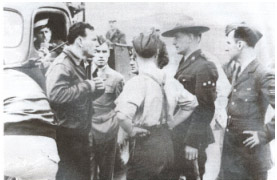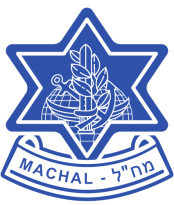
Schindler being questioned by Canadian Mounties at Halifax Royal Canadian Air Force base, with airmen looking on.
Irvin “Swifty” Schindler made front-page news in July 1948 when he tried to smuggle a World War II B-17 bomber into Israel. He was also a key person in the successful effort to purchase transport aircraft in the U.S. and ferry them to Israel during Israel’s War of Independence. His ownership of a license for a charter airline, Service Airways, provided a perfect front for the transport planes Israeli operatives were buying to provide transport for arms purchased in Europe.
In addition, his fortuitous friendship with a man who had connections with the President of Panama opened the way for these same planes to be transferred surreptitiously to a newly-created Panamanian airline, avoiding a U.S. embargo on sales of planes to Israel. Schindler earned the nickname “Swifty” because of his quick gait, especially on the tarmac.
Swifty was a native of Miami, Florida, and learned to fly at a small airport in Gainesville while attending the University of Florida. During World War II he flew four-engine aircraft between the U.S. and Europe, carrying supplies to combat zones and bringing back wounded troops.
He began working with Haganah operatives in the U.S. in 1947, especially with Al Schwimmer, and used his knowledge and experience with heavy transports to advise on the types of aircraft needed to bring war materiel from Czechoslovakia to Israel.
His attempt to fly a B-17 from Westchester County Airport in New Jersey to Czechoslovakia was unsuccessful, but later became a headline-making cat-and-mouse game with the FBI. Swifty was forced to land the plane at a Royal Canadian Air Force Base in Halifax, Nova Scotia, because of deteriorating weather conditions, faulty navigation equipment and a fuel leak. As he was sitting in the pilot’s seat of the B-17 on the ground at the Westchester Country Airport, one of seven other volunteers on the plane – none of them pilots – said to Swifty, “Man, you have a lot of guts to fly a plane like this.” Swifty replied, “No, you have a lot of guts to be flying with me. I have never been in the cockpit of a B-17 in my life.” It was a true statement.
He was apprehended by Mounties, and received an order to return to New York or Boston, but he delayed the trip till nightfall and thus managed to elude the FBI plane escorting him in the dark. However, while in the air, one engine cowling flew off and two others tore loose, necessitating his return to base. The American coast guard escort flew back to the States. The two loose cowlings were repaired, but the cover to the No. 4 engine had fallen into the sea.
The next evening, Schindler took off, headed east and flew low to avoid radar. Without a cowling cover, the fourth engine began to heat up, and Schindler was forced to shut it down and the B-17 continued on three engines over the great circle route, passing south of Nova Scotia, landing in the Azores in the early hours of 18th July. Again the State Department interfered and the crew was arrested and returned to the States by a commercial flight. There Schindler pleaded guilty to the “illegal export of planes,” and was given a one-year suspended sentence by the federal judge. His crossing of the Atlantic by the northern route on three engines was considered by RCAF officials “a brilliant piece of flying.”
Previously, on 12th June 1948, three other weather-beaten B-17s, former heavy bombers of the U.S. Air Force, taxied out from a remote corner of the Miami airfield and commenced their take-off roll. They were flying the southern route via San Juan, Puerto-Rica, Brazil and French West Africa, landing late on the night of 13th June at Santa Maria, Azores. Then they flew non-stop to Zatec, Czechoslovakia, where they were overhauled and refitted with bomb racks and rudimentary bombsights.
Following the War of Independence he became one of the first pilots for El Al, moving with his family to Israel for two years. When Swifty left El Al to return to the U.S., he became a developer, mortgage broker and a well-known talk-show host on a Miami radio station. He died in September 2007 at the age of 91.
A note from Harold Livingston (radio operator with LAPSA and Machal volunteer with Air Transport Command)
Although Swifty is known for having failed to deliver a B-17 bomber to Israel, what is less known is the very major role he played in the creation of the Israel Air Force. He has never received the credit justly due to him.
In late 1947, on behalf of the Haganah, Al Schwimmer purchased ten Curtiss Commando C-46s and three Lockheed Constellations. The corporate cover for these aircraft was Swifty’s privately owned company, Service Airways. Overnight, with its thirteen airplanes, Service Airways became the largest, legitimately licensed non-schedule airline in the United States with Irvin R. Schindler as President and CEO. When the U.S. government moved to impound the aircraft, Swifty was instrumental in the formation of LAPSA, the Panamanian airline to which the aircraft were transferred. Now, as an “international airline,” LAPSA’s airplanes delivered the munitions and supplies to Israel so vital for its victory in the War of Independence. Without LAPSA, the end results might well have proved quite different. Without Swifty, there would have been no LAPSA.
Source: American Veterans of Israel newsletter Spring 2008 and research by Joe Woolf.

